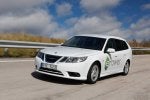
[ad#post_ad]Remember Saab? That's right, they used to be one of GM's brands before they were sold off to Spyker and the Swedish government in bankruptcy proceedings.
Now in an ironic twist of sorts, the new Saab has announced its own pure electric car.
It is called the Saab 9-3 ePower and as Saab reports is "the first practical family estate with all-electric propulsion." It will debut in the flesh at the upcoming Paris Motor Show
Saab will build a limited production run of 70 of these vehicles for a test fleet to be used in Sweden from 2011-2012. The car is a result of a co-operation between Saab Automobile, Boston Power (batteries), Electroengine in Sweden AB (electric power trains), Innovatum (project management) and Power Circle (Sweden’s electric power industry trade organization).
The vehicle will sit atop the "Phoenix Architecture" platform which will also underpin the next gen 9-3 and 9-5. These prototypes will eventually lead the way to future all electric medium and large sized sedans.
The ePower has a 35.5 kwh lithium ion battery pack designed to operate in especially old climates down to minus 30 degrees C, "at least 10 degrees C below the operating level of other battery packs on the market," claims Saab. It is air rather than liquid cooled, something Saab calls a "key benefit" by reducing weight and cost. The pack is designed to last for 10 years of regular use and can be recharged from 3 to 6 hours. Saab claims the range will be 124 miles (200 km).
The battery sits in a tunnel in the floor of the car filling the space normally occupied by the fuel tank and exhaust system. Motivation is provided by a 135 kW/184 hp electric motor driving the front wheels through a single speed transmission. This configuration will allow a zero to 60 time of about 8,5 seconds and a top speed of 93 mph.
Hundreds of drivers and their families throughout Sweden will be enlisted to drive the 70 cars across a variety of real-world conditions, making the program similar to a smaller version of BMW's MINI E trial.
“This program is designed to evaluate the potential for developing a high performance, zero emission electric vehicle and is an important next-step in the extension of our EcoPower propulsion strategy,” says Mats Fägerhag, Executive Director, Vehicle Engineering at Saab Automobile. “This includes engine rightsizing, which exploits Saab expertise in turbocharging, as well as the use of alternative fuel, such as bio-ethanol through Saab BioPower technology.”
“By 2015, annual global sales of electric vehicles are expected to reach 500,000 units and Saab is determined to be represented in this important, growing segment," adds Jan Åke Jonsson, Saab Automobile’s CEO adds. “The 9-3 ePower program is our first step towards developing a potential production vehicle that will deliver the sort of advanced performance our customers expect. We now look forward to working with our technical partners in developing such a product.”
Source ( Saab )
[ad#postbottom]










